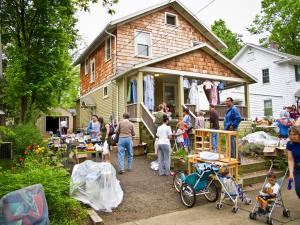Reducing your carbon footprint at home through reuse
Submitted by Julie R Butler on | Updated Sat, 17/09/2016 - 23:49

Beyond reducing your consumption of resources and energy, the next best lifestyle strategy for decreasing your impact to help slow climate change is to reuse as much as possible. To find the carbon savings of reusing a particular item rather than throwing it in the trash, numerous factors must be considered – and it can get pretty complicated.
Carbon footprinting and embodied energy
There are many carbon calculators available on the Web to help you estimate the amount of greenhouse gas (GHG) that you and your household emit each year, measured in CO2 equivalents (CO2e, often simplified to just CO2). They take into account both your direct footprint, which measures the GHG emissions from the fuel you burn through such activities as home heating and transportation, and your indirect footprint, which includes emissions over the entire life cycle of the products and services you use, from the extraction or harvest of materials and food, to the production and transport of goods, provision of services, use and maintenance, and end-of-life management. According to the U.S. EPA (.pdf), a 2009 report estimated that approximately 42 percent of U.S. GHG emissions are associated with materials management, another term for the tracking of the constituent materials that that make up products. Also, although more difficult to quantify on a per-item basis, there are factors such as product R&D and marketing to consider, as well.
The full accounting of the energy used over the lifetime of a particular product is known as its embodied energy. By reusing a product, you are extending its cradle-to-grave life cycle, thus mitigating the item’s impact by getting more use out of it, avoiding the need to create a new item from scratch, and reducing the emissions caused by its incineration or by sending it to a landfill. The problem with landfills is that any organic materials in a product, such as paper and cotton, will decompose and produce methane gas (CH4). The latest U.S. inventory of GHG emissions states that, in 2013, landfills emitted 114.6 million metric tons of CH4, which is 25 times more effective at trapping heat in the atmosphere than CO2.
Examples of food and home items
As for the beginning of a product’s life, a great example of what is involved in calculating embodied energy is the lifecycle impact assessment conducted on a pair of Levi’s 501 jeans in 2006. It includes everything from producing the fertilizer to grow the cotton to the extraction, refinement, and molding of the metal for the zippers and rivets. The final figure came to 32.3 kg CO2e, with a whopping 58 percent of the embedded energy used by the consumer, assuming warm-water washing and machine drying once a week for two years. This example illustrates how great your impact can be on the the life cycle of a product, as you can significantly lower the total figure by washing less often, using cold water, and line drying your jeans, in addition to donating them or repurposing the material after you can’t wear them anymore.
Because of the vast complexity of determining the carbon footprint for each individual product that you have in your home, in even the most detailed calculators, carbon footprints for everyday consumer items are commonly available for only a limited number of representative items, basically, to offer you a general idea. For example, co2list.org offers up some generalized food categories, showing red meat at 22 kg CO2e per kg of product, versus chicken at 6, cereals and carbs at 3, and fruits and veggies at 2. Also, if you check out the “Other Home Items” section of the list, you’ll notice that the figure of 61 kg per kg of product for a personal computer really stands apart from the other products listed.
Keep in mind that these numbers are very approximate, as the footprint of a particular item varies widely between different styles and brands, and there is no standard methodology used by all companies to estimate the carbon footprints of their products. Also, the matrices used by each carbon footprint database vary, and as I’ve already mentioned, the way you use and maintain each item often has a major impact on the embodied energy over its lifetime.
Despite all the variables that effect the accuracy of the figures, the concept of embodied energy remains helpful in understanding how extending the lives of everyday items and avoiding the need for new products through reuse can lower your impact on climate change.
Home electronics
The EPA states that the average U.S. household uses about 24 electronic products, including laptops and PCs, cellphones, televisions, audio equipment, and e-book readers. These items have a considerable amount of embodied energy from extraction and production of materials such as metals, plastic and glass.
Consider the life cycle of a smartphone. The circuit board contains copper, gold, silver, lead and palladium. The LCD display is made with glass, liquid crystalline and plastic, which is produced from crude oil. And the rechargeable battery contains lithium metallic acid. While, here again, each item’s footprint depends on how often you use it, the Guardian reported in 2010 that one estimate put the emissions caused by manufacturing a cellphone at 16 kg CO2e and emissions over the lifetime of a phone in use for an average of two years at about 94 kg CO2e.
Automobiles
The carbon footprint of just the production phase of an automobile involves extracting ores and metals and turning them into parts as well as producing and assembling rubber tires, plastic dashboards, paint, electronics and more. The Guardian’s 2010 ballpark estimate resulted in a new car production footprint of 17 tons of CO2e for a mid-sized car such as the Ford Mondeo.
The upshot? “It’s often better to keep your old banger on the road than to upgrade to a greener model.” If you take good care of your vehicle and get it to last 200,000 miles rather than 100,000, the emissions for each mile driven over its lifetime could drop by as much as 50 percent. In effect, you’re getting more distance out of the initial production emissions. And if you drive less through methods such as alternative modes of transportation (biking or public transportation), planning, carpooling, and car sharing, you might even be able to extend the life of your car long enough for the cost of an electric vehicle to drop into your range!
Houses
…and then there’s the Big One: your home. As with automobiles, you may be facing the dilemma of whether to invest in a brand new, high-efficiency home, versus upgrading the home you already have. And again, the embodied energy equation most likely comes out in favor of holding on to your old home, due to the energy required to procure, produce, and transport new building materials, which has been estimated to be more than three times that of the materials for refurbishing. TreeHugger reports on a 2009 study stating that embodied energy accounts for 28 percent of a home’s CO2e emissions over the first 50 years, noting that it usually takes more than 50 years for new homes to make up for this in lowered operational emissions.
Different approaches to embracing embodied energy
Without having to know the carbon footprint of each individual product or service, being aware that things in the modern world have complex lives, each with its own embodied energy, and that you are an active participant in those lives gives you a broader viewpoint. Movements such as the Story of Stuff Project that are putting things into perspective in a way that people can wrap their heads around have been successful in raising awareness of this issue on a wider scale.
This kind of approach is resonating with people throughout the world, dovetailing with trends going by names such as “simple living,” “frugal living,” “downshifting,” and “life hacking” that encourage us all to make do with what we already have, instead of consuming new products, and to get creative about reusing. And then there’s the new sharing economy, which started out as a community-approach to more affordable living, before the term was coopted by the Uber and Airnb corporate model. And even the EPA has taken up a new approach, using the term “sustainable materials management” to emphasize how extending the useful life of materials reduces each item’s GHG impact – along with yours.
Different ways to reuse
There are many ways to reuse everyday household items such as old clothing, hardware and tools, kitchenware, and furniture that will keep them out of the landfill for a while longer and give them a new life, either in someone else’s hands or as something entirely new. Here are some ideas:
>Thrift shopping: Reuse other people’s stuff or offer you’re used stuff to others through thrift shops, garage sales, vintage stores, buy-sell forums and other second-hand outlets.
>Borrowing and sharing: Schemes for swapping, sharing, borrowing and renting everything from housing to bicycles to garden and building tools to community solar are a growing trend. These schemes are particularly efficient when you engage at the local level through community-building initiatives.
>Donating: Avoid sending items that are still useable to the landfill and help provide for people in need by donating to charities or resale organizations. Check out the resources below, or look for opportunities in your local community.
>Repurposing and upcycling: This is where your creativity can really shine, and the possibilities are infinite! If you need ideas, there are many resources to be found online. One centralized location that makes it easy to find DIY, repurposing, recycled craft, and upcycling project ideas and instructions from across the Web is Pinterest.com. Note all the awesome ideas out there for repurposing that pair of old jeans – you’ll be inspired!
Reuse resources
EPA: Reducing and Reusing Basics
Freecycle Network – Reuse and recycling resources
UEAgain.com – Support clothing, shoe, and household textile reuse and recycling
Donate to Vietnam Veterans of America
Donate in-kind to Make-A-Wish Foundation
Money Crashers, Donation resources – Electronics (more listings in “Related Articles”)
Consumer Reports, Electronics trade-in programs
Wikipedia, Peer-to-peer carsharing
Pinterest.com – DIY resources
Shareable.net – Connection hub for the sharing transformation
References
http://epa.gov/climatechange/climate-change-waste/life-cycle-diagram.html
http://www.epa.gov/epawaste/nonhaz/municipal/pubs/2013_advncng_smm_fs.pdf
http://www.designlife-cycle.com/denim/
http://www.co2list.org/files/carbon.htm
http://www.epa.gov/smm/electronics/index.htm
http://www2.epa.gov/sites/production/files/2015-06/smartphone_infographic_700.jpg
http://www.theguardian.com/environment/green-living-blog/2010/jun/09/carbon-footprint-mobile-phone
http://www.theguardian.com/environment/green-living-blog/2010/sep/23/carbon-footprint-new-car
http://www.bloombergview.com/articles/2015-04-08/clean-energy-revolution-is-way-ahead-of-schedule
http://www.epa.gov/epawaste/conserve/smm/index.htm
http://www.livescience.com/48111-more-sharing-less-carbon-pollution.html
http://mashable.com/2010/04/29/donating-electronics/
You will save the Earth by sharing and/or tweeting (corny right?)





